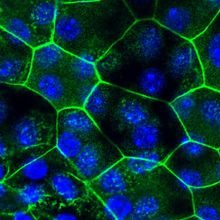cell death

Optimizing Sample Preparation for Cellular Research
The Scientist Staff | Jun 13, 2024 | 1 min read
A new approach based on Levitation Technology helps researchers minimize cellular stress during sample preparation.

Multiplexing Caspase-Based Apoptosis Assays with Automated Microscopy
Leica Microsystems | May 29, 2024 | 1 min read
A state-of-the-art automated microscope streamlines data acquisition and analysis for multiplex assays.

Programmed Cell Death
The Scientist | Mar 4, 2024 | 1 min read
Multicellular organisms can self-destruct their cells through a variety of mechanisms.

Infographic: Gene Activity in the Cellular Afterlife
Iris Kulbatski, PhD | Dec 4, 2023 | 3 min read
Low oxygen resuscitates gene transcription after death.

Unraveling the Mystery of Zombie Genes
Iris Kulbatski, PhD | Oct 31, 2023 | 6 min read
Digging into how and why some genes are resurrected after death sounds morbid, but it has practical applications.

Bladder ‘Memory’ Influences Urinary Tract Infection Recurrence in Mice
Alejandra Manjarrez, PhD | Apr 12, 2023 | 3 min read
Urinary tract infections leave permanent epigenetic marks in the mouse bladder epithelium, reprogramming its response to subsequent infections, a study finds.

Programmed Cell Death Pathways
Elina Kadriu | Feb 15, 2023 | 7 min read
Cells use a variety of programmed cell death mechanisms to maintain homeostasis through cellular self-destruction, including apoptosis, necroptosis, and pyroptosis.

Artificial Blood Breathes New Life Into Dead Pigs’ Cells
Andy Carstens | Aug 3, 2022 | 2 min read
A study’s authors say their oxygenating cocktail may lead to technologies that preserve organs in deceased people for longer periods for transplantation.

Move Over Apoptosis: Another Form of Cell Death May Occur in the Gut
Natalia Mesa, PhD | May 18, 2022 | 6 min read
Though scientists don’t yet know much about it, a newly described process called erebosis might have profound implications for how the gut maintains itself.

Why Might Cells Die or Fail to Thrive in Culture?
MilliporeSigma | Mar 29, 2022 | 1 min read
Learn more about cell culture best practices.

Tumor Cells on Brink of Death May Trigger Metastasis
Alejandra Manjarrez, PhD | Mar 25, 2022 | 5 min read
A new study reports that human colon cancer cells at imminent risk of death can instead develop characteristics needed to colonize new parts of the body.

Neurobiologist Dave Schubert Dies
Kerry Grens | Aug 24, 2020 | 2 min read
The Salk professor developed the institute’s first neurobiology lab and used it to develop cell lines, describe amyloid β toxicity, and screen for compounds that protect against neurodegeneration.

Could Curbing Runaway Immune Responses Treat COVID-19?
Shawna Williams | Apr 21, 2020 | 5 min read
Drugs targeting patients’ immune systems, rather than the virus itself, could be key to recovery from severe cases of the disease, some researchers suggest.

Dying Cells Push the Mouse Immune System into Killing Tumors
Katarina Zimmer | Jun 21, 2019 | 4 min read
Introducing either necroptotic cells or an enzyme that triggers necroptosis can wipe out cancer.

Image of the Day: Sticky Telomeres
Chia-Yi Hou | May 16, 2019 | 1 min read
Telomeres in cancer cells exposed to oxidative stress got shorter and stickier.

The World Within
Bob Grant | Feb 1, 2019 | 3 min read
Internalizing the environment might be the next step in humans’ relationship with our planet.

Infographic: How Cells Cheat Death
Charles Q. Choi | Feb 1, 2019 | 3 min read
Apoptosis and other types of programmed cell death appear to be reversible.

Cell Death Processes Are Reversible
Charles Q. Choi | Feb 1, 2019 | 10+ min read
Molecular programs can rescue cells already engaged in the process of apoptosis or other forms of programmed cell death.

Image of the Day: Pseudomonas Autophagy
The Scientist and The Scientist Staff | Mar 30, 2018 | 1 min read
Researchers identify antibacterial functions of cell death in Arabidopsis when the plant is infected with Pseudomonas.
